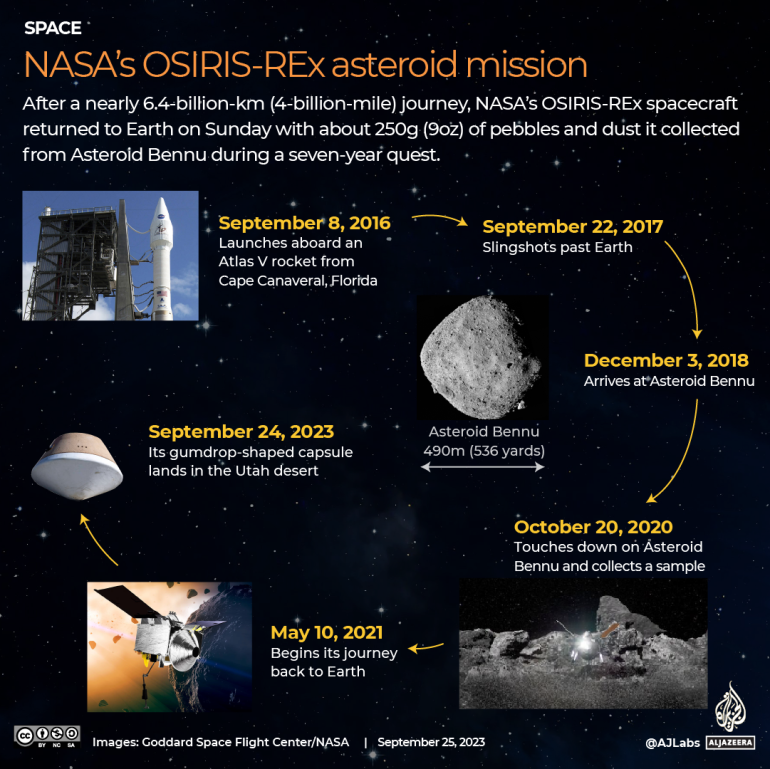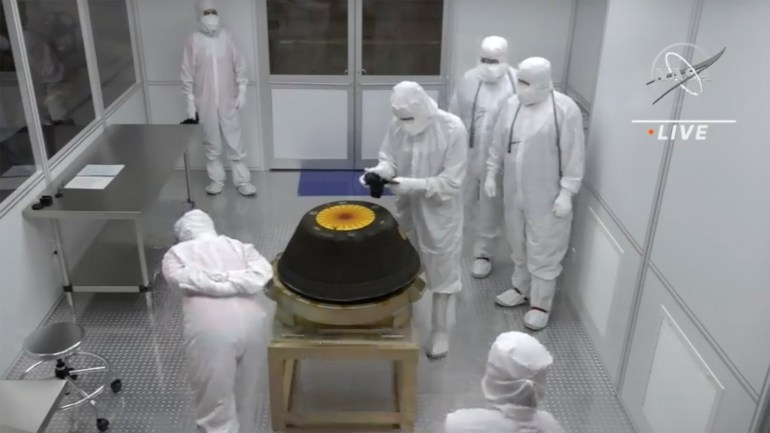NASA’s OSIRIS-REx has delivered an asteroid sample on Earth. What next?
Scientists will analyse the asteroid sample to investigate the origins of life on Earth.

A NASA space capsule carrying the largest sample ever collected from an asteroid landed on Utah’s Test and Training Range on Sunday.
The capsule was released from the robotic spacecraft, OSIRIS-REx, which was launched into space seven years ago and collected the sample in October 2020.
Keep reading
list of 3 itemsNASA’s OSIRIS-REx to bring samples of asteroid Bennu to Earth: What to know
NASA capsule carrying largest asteroid samples lands on Earth
Scientists say this sample will help them learn more about the origins of the solar system.
Now that the space capsule is back on Earth, here is what happens next:
What happens to the OSIRIS-REx?
The OSIRIS-REx spacecraft did not return to the Earth’s surface.
Instead, it separated from and released the gumdrop-shaped Sample Return Capsule into the Earth’s atmosphere.
About 20 minutes after the release, the spacecraft diverted past the Earth to its next mission, which is its journey to another near-Earth asteroid named Apophis.

The OSIRIS-REx, now renamed OSIRIS-APEX (OSIRIS-Apophis Explorer), will study Apophis when the asteroid comes close to the Earth in 2029.
The spacecraft plans to capture a close-up of the asteroid. It will also use its gas thrusters to attempt to dislodge and study the dust and rocks on and around the asteroid’s surface.
What happens to the asteroid sample?
The sample was collected from the capsule’s landing site in Utah and transported to a temporary clean room, where it was cleaned and disassembled.
The components of the sample were packaged and measures were taken to prevent the sample from contamination, NASA said.
The packaged components, alongside the unopened sample canister, will be delivered to NASA’s Johnson Space Center in Houston on Monday. Some fine-grained material at the top of the canister will be quickly analysed.
The initial analysis of this sample will be broadcast from the space centre on October 11.
Pierre Haenecour, affiliated with the University of Arizona and a member of the OSIRIS-REx team that studies organics and pre-solar material, told Al Jazeera that the sample will provide an “unaltered, pristine insight into the building blocks of the solar system”.
For the next two years, scientists will study and catalogue the sample in a dedicated clean room at Johnson Space Center.

In about six months, the sample catalogue will be released and the sample will be available for scientists to study.
Soon after this, the sample will be distributed for examination and research. About a quarter of the sample will be distributed among the OSIRIS-REx team, which comprises 233 scientists representing 38 institutions globally.
Portions of the sample will also be distributed to partner space agencies in Canada and Japan.
The remainder, about 70 percent of asteroid material, will be stored at NASA’s Johnson Space Center and in a backup facility in White Sands, New Mexico.